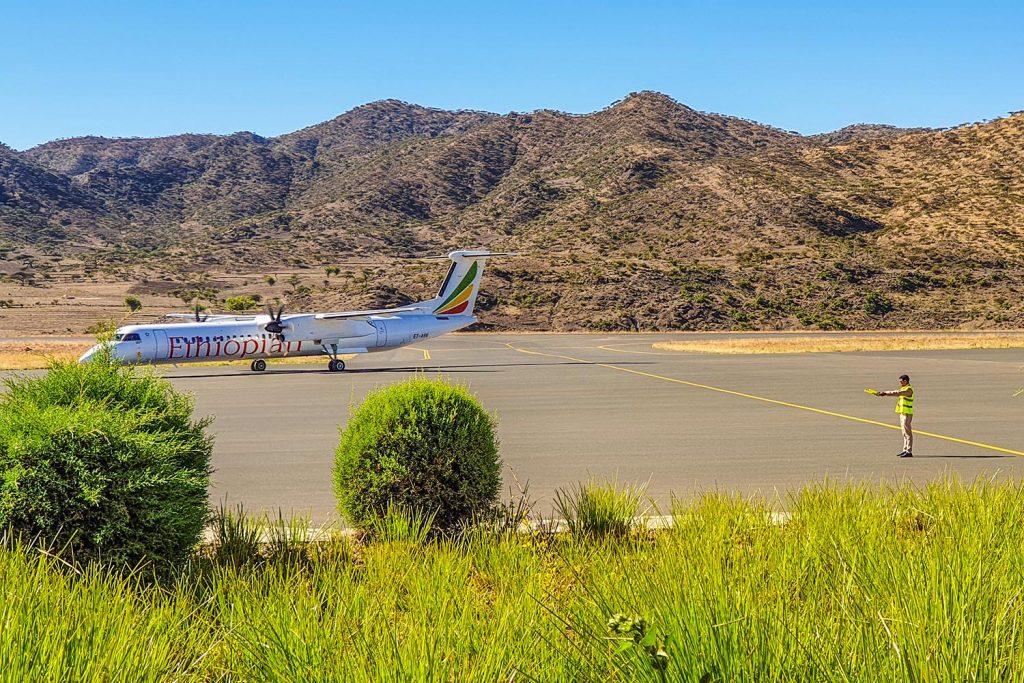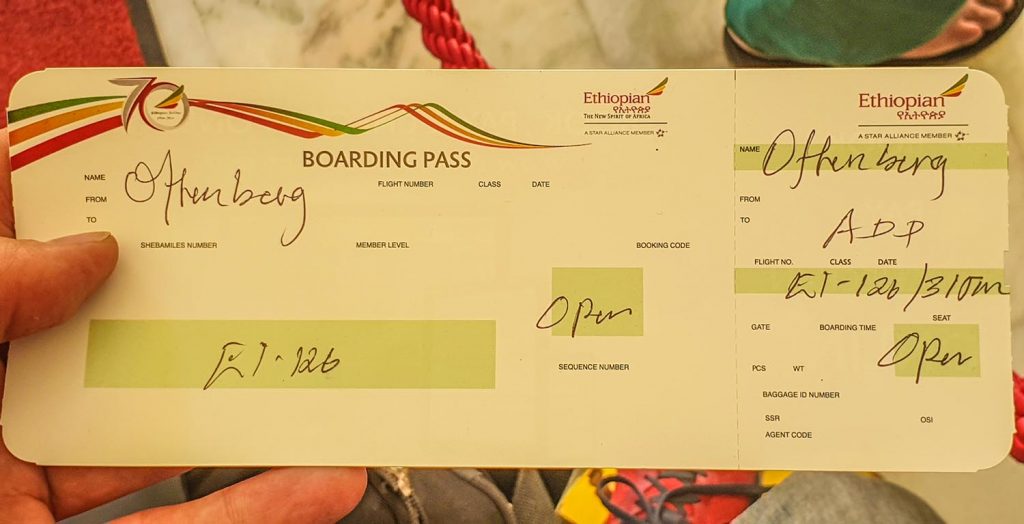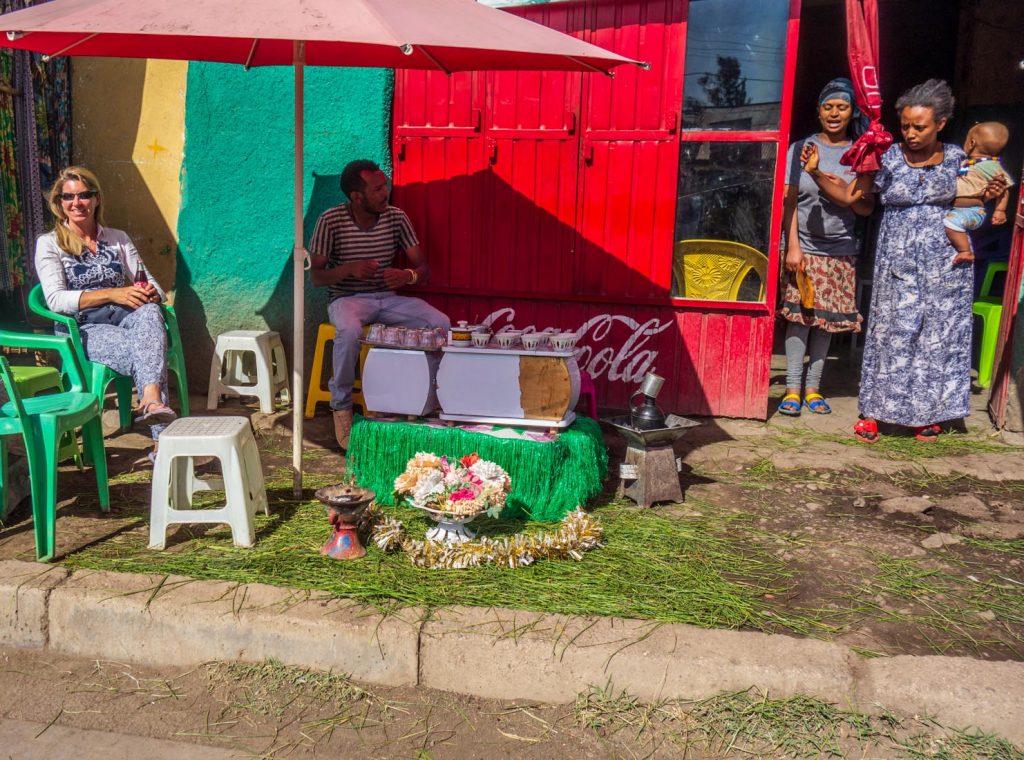Today it was time to say good bye to Lalibela and our great team at Simien Eco Tours. While we were scheduled to board a flight to Addis, they were to return by car to Gondar.

After a nice breakfast we drove 30 minutes to Lalibela Airport, the second largest in Ethiopia after Addis Ababa. On the way Esther finally got her pic of a donkey foal, which wandered with his mom along the road. They are soooo cute! Would fit so nicely to our horse collection…

The air strip looked well maintained and we expected the airport to be efficient and functioning well, after all there are only a few flights a day departing or landing here.

Well when we arrived none of the computers or wireless were working and the friendly staff was checking everyone in by handwritten boarding passes (just looking at our email flight confirmation) with free seat assignment and kept hand written passenger lists and baggage receipts. We’re wondering if we’ll get miles for it (Ethiopian is a very, very proud Star Alliance member).

Neither did they know how many exactly were to be on the plane, they did not weigh any bags either. Luckily Chris drone wasn’t an issue at all (specially Lalibela is known to confiscate drones and to send them to Addis Ababa for pickup once you leave the country). So, we just hoped that there were enough seats on the plane and we were not overloaded.

The flight was only about 50 minutes and they did serve a drink and a muffin.
Marco, the owner of Simien Eco Tours picked us up at the Addis airport and we had a nice lunch together. He showed us where to buy the best Ethiopian coffee beans. Early afternoon, a driver took us to our last lodge, at a nice lake outside Addis for a relaxing final day and a half.

Arriving at Debre Zeyit, also called Bishofftu, the first thing Chris noticed was that they seemed to just add random letters to words for the fun of it. Each word on any shop sign seemed to at least have three double letters, as if that was the latest fashion. Restaurant for example was often spelled Ressttoorant. Really funny.

As always, we saw plenty of action going on where Ethiopians favorite past time is concerned. In each village or town, there are at least several kicker / table football on the street and always a group of boys playing passionately as well as at least one billiard table in each village, often many more. Various covers and canopies try to keep the dust out.

After an hour and a half drive, we arrived at Viewpoint lodge, a small yet charming place overlooking the Babogaya lake.

It had a wonderful terrace overlooking the entire lake with its many birds flying back and forth between trees and reed grasses.

Our room was a round mud hut but it did have a small bathroom. Draw back was that it was close to the road.
Our other option would have been more quiet but neither with bathroom, nor toilet. We picked the first. We enjoyed a very relaxing afternoon and nice sunset there.

Normally we do a food blog as one of the entries, but frankly in Ethiopia the most amazing things we found were the menus themselves. We found amazing things on it: ‘Chees Berger with mined beef’, ‘Spaghetti with cheese dumping’, ‘Stake ala bis mark’, ‘fillet mignon café depari’… Of course, once you ask for a filet mignon you’ll learn that “we no have”. Today? Ever?

In short most food is medium spicy and Ethiopians honor Wednesdays and Fridays as fasting days, which means they don‘t eat meat on those days. Then only vegetarian dishes are on the menu.

Main ingredient of any Ethiopian dish is injera, the sour dough, pancake like bread that serves as a base for all dishes and it serves as cutlery at the same time. Ethiopian cuisine offers traditional vegetables such as beans, chick peas, cabbage, carrots, spinach or lentils and one always gets a good tomato and green pepper salad (green peppers as in green chilies…)

Ethiopians eat with their right hand and no cutlery, so we adjusted quickly. We love finger food anyway.
On fasting days, a very popular dish is Shiro, a spicy bean paste that gets served hot on top of injera bread. Aside from the vegetables, the meat served is mostly sheep or goat. We did have some chicken and beef, but that was mainly in the larger cities we drove through. We have to say that most meat was very tough. Animals seem to get slaughtered before they pop their clocks naturally, so our ox must have been at least 20 years old and even the chicken was tough in some places.
While Ethiopian cuisine knows some delicious soups, desserts seem to be absent in every menu, much to Chris’ chagrin. Whereas the fresh mango juices were delicious and common throughout.
After each meal or at breaks, often the traditional coffee ceremony was performed, which would delight Espresso drinkers, because that‘s basically what it tastes like. No milk and plenty of sugar. Burning frankincense is part of the ceremony, Chris’ guess was that it helps to attract more people. Which doesn’t work with Esther since she is not to keen on the smell of it.

Let us summarize our culinary experiences in Ethiopia as quite good (Esther) or as OK (Chris), but don‘t travel Ethiopia for the food. There are other countries with much more variety throughout. Nevertheless, we tried almost everything and never got sick, which is already a positive fact.
After having had Shiro for lunch we felt the need for something different so we had spaghetti for dinner (Pizza and Pasta are omnipresent here, a left overs from the short time of the Italian occupation) and had a pleasant conversation with some nice Swiss bird watchers which rounded out our last night in Ethiopia.





